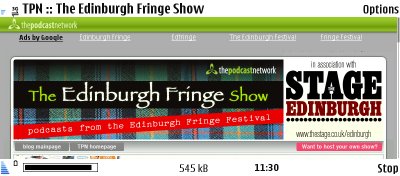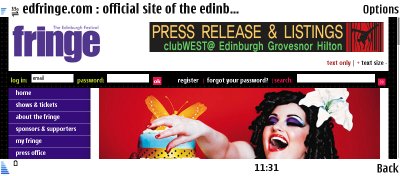My adventures with the Nokia E90 at the Edinburgh Festival continue, and there’s a lot of feedback in the comments to the previous sections. Someone wanted to know why I wasn’t reviewing all the gee-whizz features in the device. Well that should be obvious – we’ve done that before in Steve’s comprehensive review of the E90 (here's the last part, on navigation/GPS, and with links to all previous parts) – the aim of my series of articles is to use the E90 in a genuine, real world environment. If I’m not in a pressing need for GPS, guess what, I’m not going to use it (and given that I’ve not seen an accuracy under 40 yards when I have turned it on, it wouldn’t be that useful in the narrow streets and alleyways of the city in any case). I’m not going to do the reviewer's thing and go into every function to see what it does. This is my life, not some stylised techno-geek E90 user. Me.
One area in which the E90 does work better than the original Communicators is in connectivity and internet access. While the 9500 (and the later 9300i) did carry Wi-Fi, the E90 carries that and then goes all the way up to HSDPA (3.5G) connectivity - I’m using an unlimited data plan from T-Mobile, by the way. By using the Webcore-based Web Browser, there’s no longer any problem in the rendering time of web sites (which was always a complaint on previous units).
Now, I’ve not been one to heap praise on Nokia’s Web browser in the past, mainly because I feel that a mobile browser should be optimised for viewing on a mobile device, and it should not attempt to replicate the page layout from a full PC on a small screen. But while the E90 screen is physically small, the 800 pixel width means that the Web Browser is actually easier to use here than on any other S60 device.
Sure, I’d like the tab key to cycle around the links and to somehow have the ability to have a key do ‘page down’, but on balance, being able to post and manage my Wordpress blog, pick up all the news and information from the web sites of acts, PR people and agencies (mostly in PDF form) means that as a portable web device it’s a good substitute (but not a perfect one) for a desktop browser, and it gets the job done while out and about. And that’s all down to the extra width actually suiting the 'desktop rendering' philosophy of the browser.
A big heads up also goes to the Java midlet engine – I’ve been relying on the Java client version of Google Mail to do my emails, and it works a dream… although I do wish someone in Nokia would have taken a bit of time to tell the E90's JVM that the soft keys are on the side of the screen, and not the bottom. Too many times I’ve hit the wrong option because I have to try and remember which is which.
And, while I haven’t used the GPS, finding one of the venues (a small café in a language school hosting a monologue from Adolf Hitler in the hour before he dies) did mean using the Google Maps applet for a local search, and then navigating by stepping through the route while looking at the map on-screen. Short, quick, useful and then put away again. That’s what I like to hear!
So why does the internet and connectivity part of the E90 work well? I think partly because the hardware and software aren’t limited – there is enough RAM, processor speed and well written software to make the internet accessible on modern smartphones to a degree that was never possible before on the communicators. So, in this instance at least, the E90 reaps the benefit of the cutting edge S60 code. Talk about a Jekyll and Hyde device.
I wonder if this positive vibe will carry over to the multimedia experience? I’ll look at that in the next part.
-- Ewan Spence, 10th August 2007



